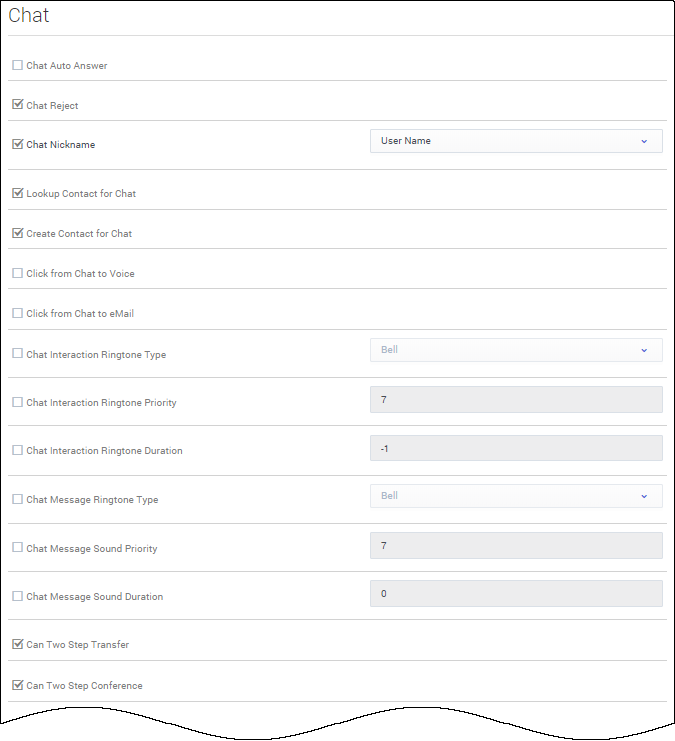Chat options
In the Chat section of the Contact Center Settings page, configure the following options:
- Chat Auto Answer specifies that chat interactions are automatically answered when an agent receives the invitation.
- Chat Reject enables agents to reject incoming chats.
- Chat Nickname specifies the nickname that is displayed on the chat window in interactions. Type one the following syntax options:
- $Agent.UserName$ to display full username.
- $Agent.LastName$ to display only last name.
- $Agent.FirstName$ to display only first name.
- $Agent.FullName$ to display full name.
- $Agent.EmployeeId$ to display employee ID.
- Lookup Contact for Chat activates Agent Desktop for contact lookup when an interaction is presented to an agent.
- Create Contact for Chat will create a contact if the initial contact lookup fails to find an existing contact.
- Click from Chat to Voice enables users to initiate a voice interaction by clicking a phone number in a chat transcript.
- Click from Chat to eMail enables users to initiate an email by clicking an email address in a chat transcript.
- Chat Interaction Ringtone Type specifies the chat ringtone type. Enable the option and then select the ringtone type from the drop-down list box.
- Chat Interaction Ringtone Priority specifies the priority level of the chat ringtone within the channels. Enable the option and then type the number for the priority level.
- Chat Interaction Ringtone Duration specifies how long the ringtone rings. Use the following values:
- -1 specifies to repeat the ringtone until the chat is answered.
- 0 specifies to play the ringtone only one time.
- 1 or more specifies to play the ringtone for the specified duration (in milliseconds) and then repeat until the chat is answered.
- Chat Message Ringtone Type specifies the chat message ringtone type. Enable the option and then select the ringtone type from the drop-down list box.
- Chat Message Sound Priority specifies the priority level of the chat message sound within the channels. Enable the option and then type the number for the priority level.
- Chat Message Sound Duration specifies the length of the sound. Use the following values:
- -1 specifies to repeat the sound until the chat message is read.
- 0 specifies to play the sound only one time.
- 1 or more specifies to play the sound for the specified duration (in milliseconds) and then repeat until the chat message is read.
- Can Two Step Transfer enables two-step transfer of a chat, beginning with a chat consultation.
- Can Two Step Conference enables two-step conference of a chat, beginning with a chat consultation.
- Can One Step Transfer enables instant chat transfer.
- Auto-disconnect automatically disconnects a chat session when the agent is the last remaining party.
- On-hold Queue specifies the Interaction Queue where a chat interaction is placed when an agent places it on hold. This option can be overridden by a routing strategy.
- Warning time specifies the time in seconds that a warning alarm alerts an agent of a customer awaiting a chat response.
- Maximum time specifies the time in seconds
- Prompt for end displays a confirmation prompt to an agent when they select End. This option can be overridden by a routing strategy.
- URL push max records specifies the maximum size of the pushed URL list.
- Timestamp specifies whether the timestamp is displayed in the Chat transcript area.
- Typing specifies whether a typing notification is sent to customers during a chat interaction.
- Typing timeout specifies the duration in seconds of when the typing notification is displayed after the last keystroke.
- Decline allows an agent to decline incoming chat interactions.
- URL push allows an agent to push URLs to customers during chat sessions.
- Interaction Disposition allows an agent to set a disposition code for chat interactions.
Comments or questions about this documentation? Contact us for support!

